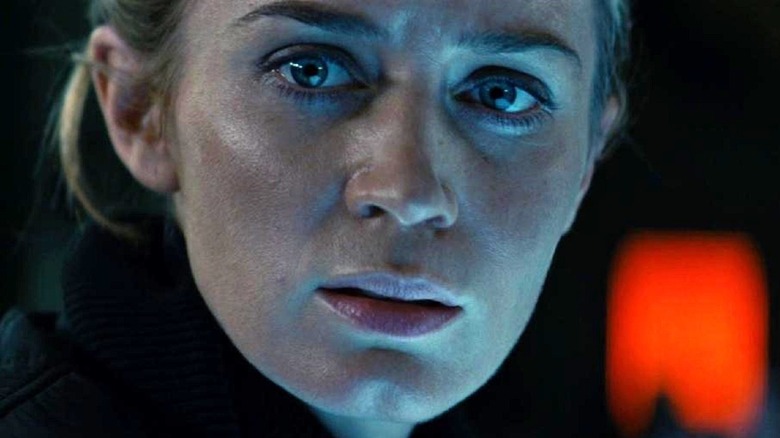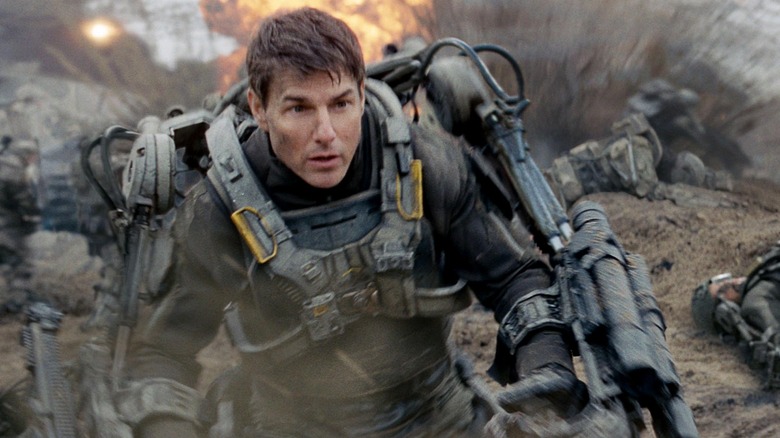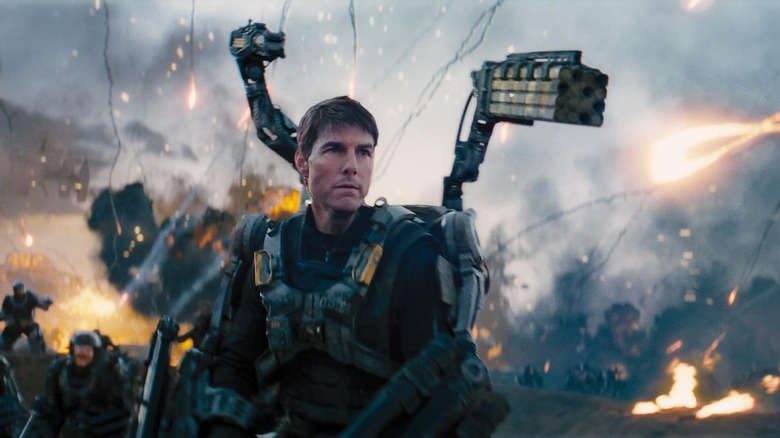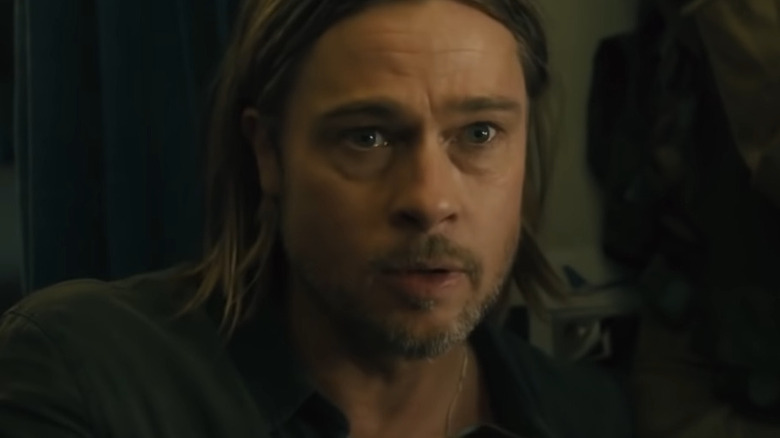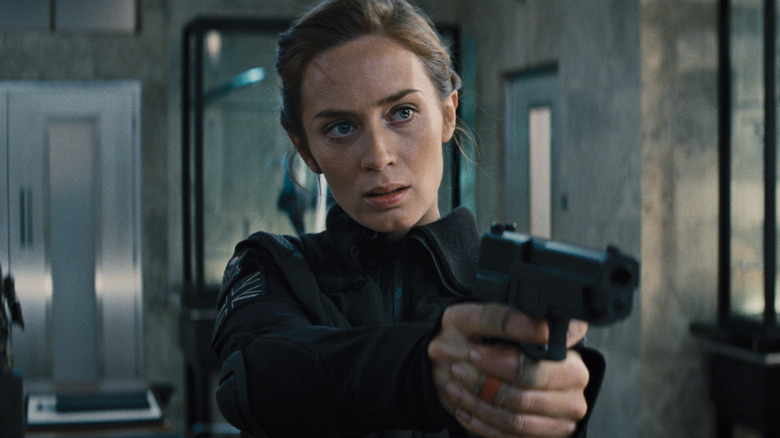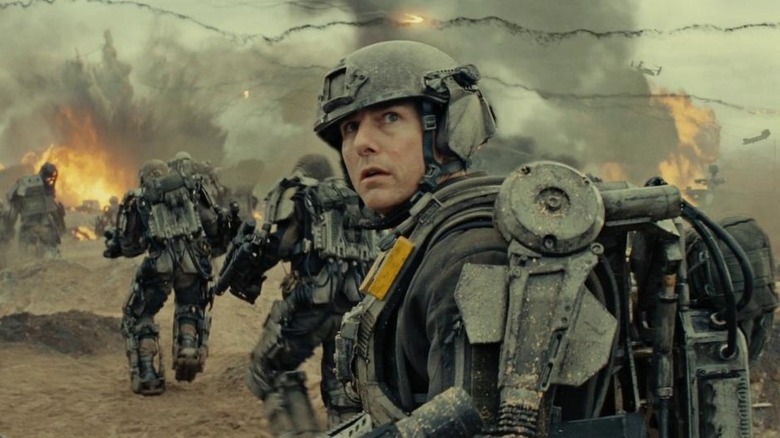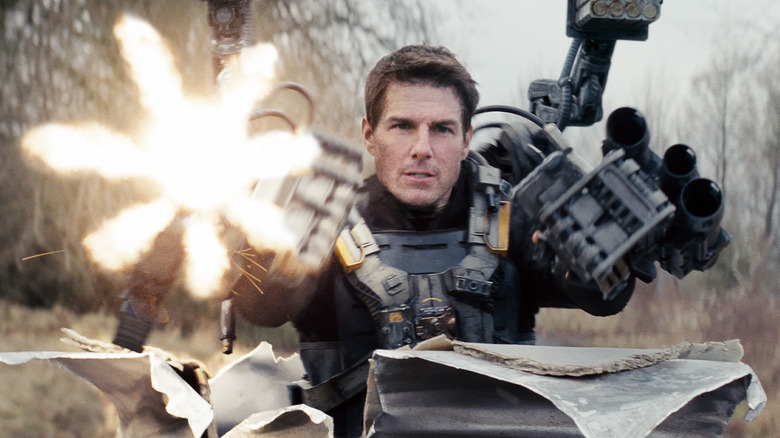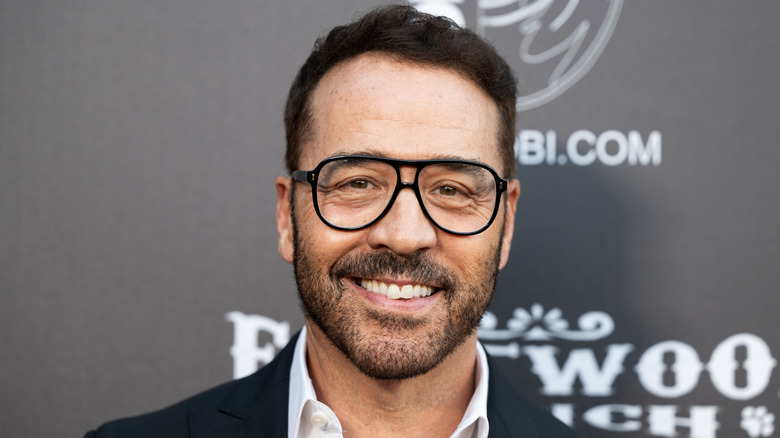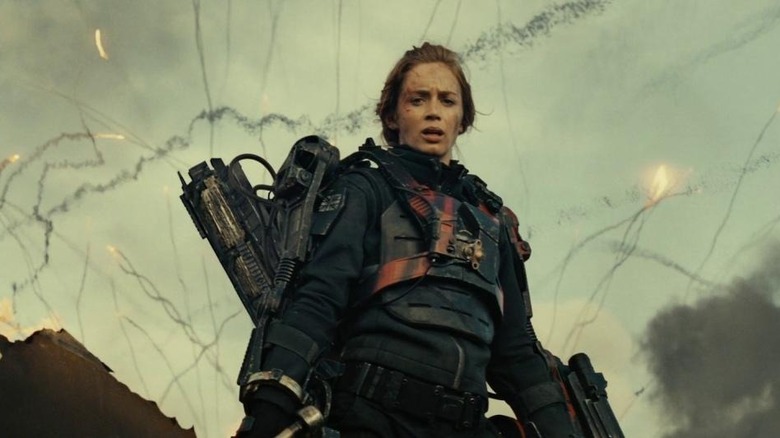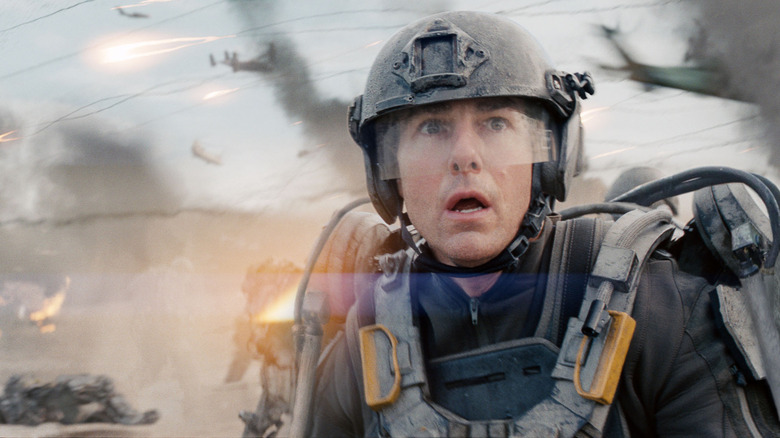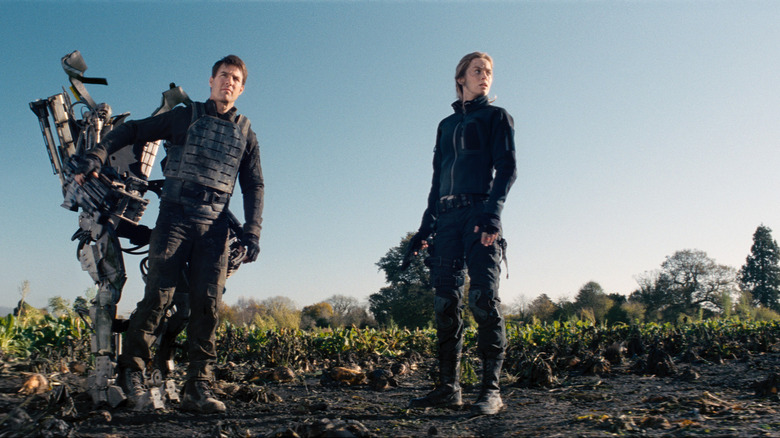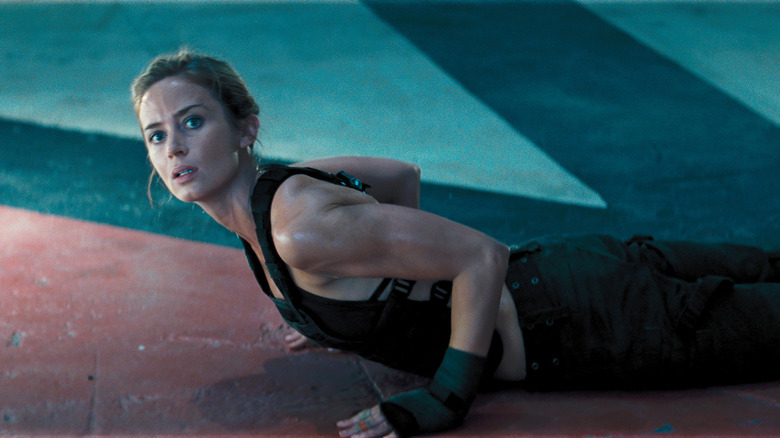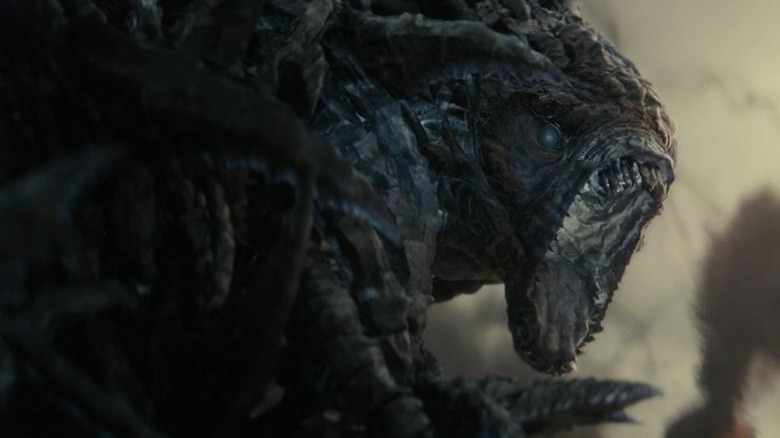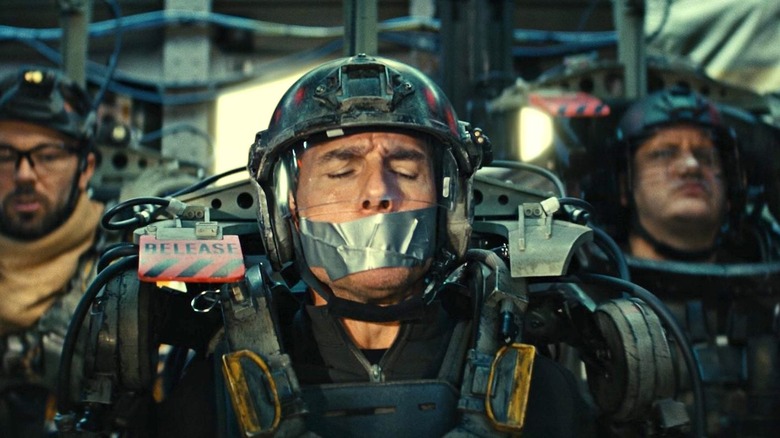The Untold Truth Of Edge Of Tomorrow
There have been many time loop movies in the history of cinema, including beloved titles like "Palm Springs" and "Groundhog Day." But there's never been one quite like "Edge of Tomorrow," which flipped the standards of both Tom Cruise action films and sci-fi blockbusters on their heads to create something unexpectedly wacky and fresh. The story of a selfish soldier who becomes encased in a time loop while fighting otherworldly invaders, "Edge of Tomorrow" turned out to be the perfect vessel to show off Cruise's comic chops and deliver some clever action set pieces. No wonder the film has garnered such a large following, especially since Emily Blunt stands out as the unforgettable action hero of the whole piece.
While the rules of the time loop in "Edge of Tomorrow" and the movie's best lines are now common knowledge, there are countless aspects about the film that aren't as well known. This includes the original choice of leading man, the tumultuous filmmaking style of its director, and even the strange saga of its unmade sequel. "Edge of Tomorrow" is a thoroughly unique entry in the canon of Tom Cruise movies, and its behind-the-scenes details are just as fascinating.
How Edge of Tomorrow was initially pitched
If you're going to try and sell Hollywood on a potential movie that isn't rooted in a deeply beloved franchise, you've got to do something drastic to make sure your idea can stand out in a crowded marketplace. To that end, screenwriter Dante Harper presented the idea of adapting the novel "All You Need Is Kill" — which would eventually result in "Edge of Tomorrow" — to Warner Bros. brass by presenting them with a finished spec script rather than just a generalized pitch for what the movie could look like.
As noted by Deadline, going this route went against most protocols for getting new movies off the ground in Hollywood. Writing a finished script for a film that isn't greenlit yet could result in a lot of work going to waste if the studio doesn't accept your pitch. But traditional pitches have become so scarce in the modern Hollywood ecosystem that Harper and producers Jason Hoffs, Erwin Stoff, and Tom Lassally all knew something more drastic was needed to get the movie on the radar of Warner Bros. executives. The result was that Harper got paid almost $3 million for his spec script even without having any filmmakers or actors onboard. As "Edge of Tomorrow's" protagonist is constantly learning, sometimes risks are well worth it.
Why Doug Liman signed on to direct
The primary focus of Doug Liman's filmography has been big crowd-pleasing blockbusters. It was a trend established with his 2002 hit "The Bourne Identity," with subsequent directorial efforts like "Mr. and Mrs. Smith" and "Jumper" continuing this trend. He's sometimes helmed smaller-scale affairs, such as "The Wall" or "Swingers," but he's usually the guy you call when it's time to direct something costly that's meant to appeal to a wide range of audience members. So it should be no surprise that he was called on to direct "Edge of Tomorrow," even if, up to that point, he had no extensive experience with sci-fi storytelling outside of "Jumper."
Still, there was more than just a track record of handling blockbusters that attracted Liman to "Edge of Tomorrow." The director revealed to Post Magazine that what really attracted him to the project was the central dynamic between a super-powered character and someone who has no abnormal abilities. Additionally, Liman gravitated towards the idea of making that non-super-powered individual a woman who could go toe to toe with the movie's male lead, continuing a fascination Liman had with empowered women that dated back to "Mr. and Mrs. Smith." These character details ensured Liman's interest in returning to blockbuster cinema with "Edge of Tomorrow."
Brad Pitt was originally supposed to star
As its leading man, Tom Cruise is central to "Edge of Tomorrow," especially as his gift for comedy really lends itself to the movie's wacky time-loop scenarios. But he wasn't always the first choice to anchor this project. Back in September 2011, Brad Pitt was the original pick to play the protagonist of "Edge of Tomorrow." This would've reunited Pitt with director Doug Liman, as the two had collaborated on the 2005 smash hit "Mr. and Mrs. Smith."
It's easy to imagine why Pitt would've been seen as a prime candidate to anchor "Edge of Tomorrow," especially since he also has solid comic chops and would've been a big enough name to draw moviegoers to watch a blockbuster that wasn't a remake or a sequel. However, he ended up passing on the part. No reason was given for why he never took on the role, but it's worth mentioning that Pitt was offered this part while he was in the middle of shooting another big blockbuster, "World War Z." It's not far-fetched to imagine that being in the middle of one massive tentpole made Pitt wary of signing on to another. Whatever the reason, Pitt turning down "Edge of Tomorrow" paved the way for Cruise to tackle one of his most interesting blockbuster performances.
The big script changes to Edge of Tomorrow
Doug Liman has never been a guy who plays things safely while making his blockbuster movies. Just look at "The Bourne Identity," which ended up being beloved but had a troubled production due to Liman butting heads with Warner Bros. It's no surprise, then, that Liman's "Edge of Tomorrow" had its share of difficulties getting to the silver screen. In this case, part of those challenges emanated from how much of the original screenplay was tossed just before principal photography got underway.
Speaking to the Los Angeles Times, Liman openly admitted that he discarded around two-thirds of the screenplay eight weeks before shooting was about to start. Liman was ready to build an entirely new vision of this new movie, with screenwriter Christopher McQuarrie joining Liman to crack this concept. As if things weren't treacherous enough, going this route didn't automatically result in a new complete script. In fact, "Edge of Tomorrow" began filming even though a complete screenplay didn't exist at that point. Despite Liman's hands-on approach to getting the story of "Edge of Tomorrow" right, the reviews for the film ended up being generally positive, with many critics specifically praising the crackerjack script. Sometimes, flying by the seat of your pants, even when it comes to the screenplay of a costly blockbuster, can be the right move.
The rejected ending
In the theatrical cut of "Edge of Tomorrow," Tom Cruise's William Cage awakens after sacrificing himself to defeat the aliens known as Mimics. As he looks around, he realizes he's been brought back in time to before the time loop mayhem started. This means that Emily Blunt's Rita Vrataski doesn't know him, but that just opens the door for their relationship to start anew. It's a tidy conclusion that brings things full circle while leaving the door open for the film's central relationship to keep going well into the future. However, this wasn't always the way "Edge of Tomorrow" was supposed to end.
Screenwriter Christopher McQuarrie explained to Film School Rejects that, originally, there was going to be an extra wrinkle in the film's ending — you couldn't kill a Mimic alien known as an Alpha. Doing that would trigger a new time loop where the aliens know the plans of the humans. This would lead to a character killing an Alpha during the finale, which leads to the time loop starting over. The difference in this timeline, though, is that the humans are wiped out before they can execute their scheme. McQuarrie had some fondness for this concept but noted that by the time it arrived in the movie, the audience would be so overwhelmed that adding more time-travel tomfoolery just felt like overkill. With that, "Edge of Tomorrow" went with a softer, more satisfying ending.
Where did Edge of Tomorrow film?
If you're a Warner Bros. movie, getting any sort of comparison to the studio's "Harry Potter" movies, the crown jewels of the company, is an honor. "Edge of Tomorrow" got to be at the center of such comparisons, albeit very tenuously, as its crew began to pick out a place to shoot this sci-fi epic. In August 2012, it was revealed that "Edge of Tomorrow" would partially shoot in the U.K. studio Leavesden Studios — which Warner Bros. had recently purchased – among other spaces in London. Leavesden had been previously rented out by Warner Bros. as a venue to shoot the first eight "Harry Potter" titles.
After having such a good experience capturing the wizarding world there, Warner Bros. decided to take over the studio and make "Edge of Tomorrow" its first movie to entirely shoot in this location after the purchase. This was an especially solid choice for a shooting space as the plot of "Edge of Tomorrow" takes place in the United Kingdom. Since this Tom Cruise blockbuster hit theaters, Warner Bros. and other studios have shot countless tentpoles in Leavesden Studios, including "The Legend of Tarzan," "Spider-Man: Far From Home," and "The Batman." But only "Edge of Tomorrow" can forever claim to be the first movie to shoot in this domain after it was purchased by Warner Bros.
Jeremy Piven was supposed to be in Edge of Tomorrow
Even once principal photography was finished on "Edge of Tomorrow," it was still being heavily tweaked and altered. Case in point — once a batch of pre-planned reshoots got underway, it was announced that a new actor had been added to the film's cast. "Entourage" leading man Jeremy Piven was now set to be a part of this sci-fi blockbuster. At the time, it was noted that he would be playing a character named Col. Walter Marx and that his participation in the feature was made possible due to Piven being on hiatus from his U.K. TV show "Mr. Selfridge."
This would've been a massive departure for Piven from his typical film roles since he usually plays in smaller-scale comedies rather than massively expensive motion pictures. However, Piven never wound up in the final cut of "Edge of Tomorrow." No reason has ever been given for why Piven ended up on the cutting room floor, though it's likely that, thanks to his presence being added in reshoots, he ended up being more superfluous than anything else. The way "Edge of Tomorrow" was constantly evolving during its lengthy production allowed Piven to get cast in the film, but its fluid nature also likely resulted in Piven getting axed from the final feature.
The challenge of wearing those battle suits
The lead characters of "Edge of Tomorrow" all must go into battle against the otherworldly Mimics by strapping on enormous exosuits, equipment that wasn't added on to the characters in post-production. Every one of the actors, including leads Tom Cruise and Emily Blunt, had to wear these outfits, which weighed 85 pounds. In a breakdown of the suits with production designer Oliver Scholl on the featurette "Edge of Tomorrow: Weapons of the Future," it was noted that an extensive amount of thought went into crafting the finer details of these outfits, including how they needed to be streamlined enough to just register as functional rather than cool. After all, these exosuits are made for war, not being sold as toys, so they aren't loaded with extra knick-knacks or glossy qualities.
Once the designs were figured out for these exosuits, there were still extensive problems with getting people in and out of the costumes on set. Initially, Cruise, for example, had to spend a whole half-hour just to get suited up, though that timespan was soon whittled down to 30 seconds. Committing to such bulky outfits doubtlessly made shooting "Edge of Tomorrow" extra difficult. But it did lend an immediate sense of tactility to this world that you just wouldn't get if the exosuits were all digital.
The big beach battle took three months to shoot
Throughout "Edge of Tomorrow," both the film's protagonist and the audience are constantly returning to a massive battle between humans and alien invaders on a beach. Per the Los Angeles Times, this expansive set piece was always meant to be a big commitment on the part of the cast and crew. However, that commitment was originally supposed to entail just two weeks. Instead, it ended up going on and on for almost three months. The constant delays stemmed from Liman improvising and making new stuff up as he went along.
As if that wasn't enough of a challenge, the movie's big beach scene was filmed on a manmade location. This expansive set took a lot of effort to keep functioning over a solitary day, let alone over multiple months. Having to keep this set in working order, not to mention Emily Blunt almost breaking her nose during all this, meant that filming this battle sequence was a trying experience unto itself. At least everyone involved can comfort themselves knowing that all the blood, sweat, and tears did result in an immensely tangible sci-fi set piece.
Christophe Beck's strange experience scoring Edge of Tomorrow
"Edge of Tomorrow" hit a major snag in post-production regarding who would be composing the music for this summer blockbuster. Doug Liman's usual go-to composer, John Powell, was on a break, so the director called in Ramin Djawadi. But eventually, Christophe Beck was selected to take over composing duties, with the composer noting to Hitfix that this Tom Cruise vehicle was the first time he'd done the score for a massive action movie.
While he was entering uncharted territory very late into the film's production, Beck navigated additional issues in trying to develop a good working relationship with Liman. Beck openly admitted that it took them a while to find proper footing with one another, particularly with navigating the tone of the score. Liman always encouraged Beck to go for more unorthodox musical choices, particularly when it came to emphasizing the movie's comedy. Working with this filmmaker never turned out to be easy, especially because Liman tended to be upfront and curt. As the composer explained, "When you're in the moment and you're hearing it from him, it can sometimes make your heart sink, but I'd much rather work with someone where you know where you stand."
Beck also noted that Liman's creative decisions and attitude were indispensable in making sure the "Edge of Tomorrow" score was something special. Plus, all these extra hurdles ensured that Beck wouldn't soon forget his first foray into scoring a sizeable summer blockbuster.
Edge of Tomorrow's title changes
Initially, "Edge of Tomorrow" was titled "All You Need Is Kill," a moniker it shared with its source material penned by Hiroshi Sakurazaka. But just before the movie was set to be promoted at the 2013 San Diego Comic-Con, Warner Bros. announced the feature would be released under the title of "Edge of Tomorrow." Head brass at the studio would later confirm that the change was due to concerns over whether or not audiences would be turned off by a movie that featured the word "kill" in the title.
The story behind the film's title got even more complicated when Doug Liman revealed to Den of Geek in 2017 that he'd pushed for getting rid of the "All You Need Is Kill" title since he felt it didn't reflect the complicated tone of the final film. However, his suggestion for a new title was "Live. Die. Repeat." The studio would instead use that as a tagline for the feature's theatrical release and opt for "Edge of Tomorrow."
Liman would get his wish, somewhat, when the home video release for "Edge of Tomorrow" rolled around and Warner Bros. began marketing the film as "Live. Die. Repeat." It's extremely rare for such big-budget movies to attempt a drastic retitling like this after they've been released to theaters, with many seeing it as a sign that Warner Bros. recognized that "Edge of Tomorrow's" title did it no favors in luring moviegoers.
The complicated box office run of Edge of Tomorrow
Before its release, "Edge of Tomorrow" was greeted with skepticism over how it would fare at the box office. It wasn't an unreasonable stance to take given that "Tomorrow" was the rare non-sequel blockbuster debuting in the summer of 2014, a season dominated by new "X-Men," "Planet of the Apes," and "Transformers" sequels. On its domestic opening weekend, it didn't look like "Edge of Tomorrow" would beat out the naysayers, with only a $28.8 million debut. On a $178 million budget, "Edge of Tomorrow" needed to have a way bigger opening to put it on the road to profitability.
However, on its second domestic weekend, "Edge of Tomorrow" ended up holding quite nicely by dipping just 43%, a much better than usual hold for a summer blockbuster. From there, "Edge of Tomorrow" managed to have strong weekend-to-weekend dips in North America and eventually scored $100.2 million in this territory and $367 million worldwide. While not a super profitable venture, "Edge of Tomorrow" did manage to do better than expectations thanks to good word-of-mouth. Plus, it gave Cruise his first-star vehicle outside of the "Mission: Impossible" franchise to crack $100 million domestically since "War of the Worlds" in 2005. Warner Bros. doubtlessly wanted "Edge of Tomorrow" to do more in its global box office run, but there was still plenty to crow about regarding how much money this title took in.
The weird status of Edge of Tomorrow 2
Not long after "Edge of Tomorrow" first touched down in movie theaters, news broke that a sequel was beginning to gestate. A few months after this first reveal, screenwriters were hired to pen a script for another "Edge of Tomorrow," and Doug Liman was confirmed to be directing the prospective project. By the time May 2017 rolled around, Liman had confirmed that this sequel would be called "Live Die Repeat and Repeat" and that Tom Cruise and Emily Blunt were excited about the project. With all these positive developments, not to mention enthusiasm from all the key creative participants of "Edge of Tomorrow," it looked like this sequel was full steam ahead.
But as the years went on, an "Edge of Tomorrow" sequel seemed to be slipping further and further out of grasp. Liman was much more uncertain on whether or not it would ever happen by January 2021, while Blunt seemed to put the nail in the sequel's coffin in February 2022 by stating that a prospective follow-up would be too expensive to ever go forward. While it doesn't seem like an "Edge of Tomorrow 2" has been officially killed, it's also looking more and more unlikely that it'll happen with each passing day.
